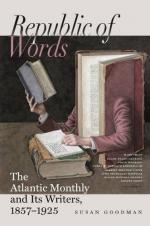Had Art always been real and artists ever true, this consideration must have called forth this class. It being true that natural scenery readily allies itself with representations of the human figure in order to express more perfectly than otherwise possible the ideal, it must be through affinity with that which evolves the ideal, and only by indirect relation to its sign or visible manifestation in form-language. Then why not found a school of landscape by discarding the human figure as an element of expression? A man comes who is born to the easel, yet who feels no impulse to represent the practical effect upon human faces and limbs of the various emotions, passions, and sentiments which demand utterance. His thought is to hold himself to his kindred by more subtile and far more delicate bonds. He knows that any one can look upon the “Huguenot Lovers,” by Millais, and feel responsive; for it occupies a great plane, a part of which may be mistaken for passion. But he feels that the love of Thekla and Max Piccolomini will permit no effigy but that sacred bank beyond the cliffs of Libussa’s Castle, whither come no footsteps nor jarring of wheels, but only the sound of the deep Moldau and of remote bells. It is the essence of the ideal which compels his imagination, not the limited and restless circumstance which chanced to occur as its revelator. Then the day uprises as if conscious of his inner life and purpose. Then she gives him breadth after breadth of color, within which is traced her no longer mystic alphabet. How significant are the forms she gives him for the foreground, sweet monosyllables! There are pansies, and rue, and violets, and rosemary. Among these and their companions children walk and learn, and to the child-man, the artist to be, she proffers these emblems. Should he accept her gifts, then all this wonderful world of Art-Nature is open to him. He inherits, possesses beyond all deeds, above all statutes,—as does Mr. Gay, who painted that great, though unassuming, picture of “The Marshes of Cohasset.”
Because Art was not held to the highest, few men have known the elevation of this department of landscape-painting. Too deep or too devoted a life seems to have been required, too constant communion with Nature, or too broad a study of her phenomena. Unfortunately, we have few representatives of this class, in Italy,—Mr. Wild producing only rarely works which to the principles hinted at are precious illustrations. After the remarks we have made, we fear that allusion to the existing facts of painting may be deemed disparaging. Not so; we deprecate such a conclusion. One great and living picture marks the man. To be true to himself and Nature is the first duty, even should he be compelled to stand lifelong with his face towards the west, in order to possess his soul in Art.
One of the pleasantest styles of landscape painting is that where the artist, in a mood of deep peace, sits down in the midst of scenes endeared by long and sweet association, and records in all tenderness their spirit and beauty. Such scenery Italy affords, and the Alban Hills seem to be the centre whence radiate all phases of the lovely and beautiful in Nature. There her forms have conspired with all the highest and rarest phenomena of light to render her state unapproachably glorious.




